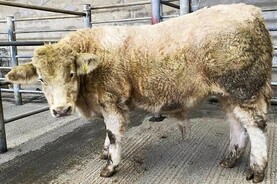Weather conditions
Grazing conditions have become a little more difficult especially in the west of the country over the last few days. Where damage is being done, housing is the best option. Where cows have to be weaned try and complete on a phased basis on dry days.
Housing cows and leaving weanlings outdoors is a good option. Weanlings will be lighter to graze and will do less damage. Heavy finishing cattle are better off housed as well if grazing in wet areas. Some farmers who had to house cattle in September have been pleased with how the cattle throve indoors and the subsequent kill outs.
Feed the best quality silage and up the meal levels to maintain performance once housed. Continental steers should go onto 5-6 kg of meal along with silage to get the desired level of finish. Good finishing rations should be able to be purchased at €300/tonne bulk delivered. Look for a high cereal content in finishing rations.
Try to house cattle on a dry day if you can and make sure you are up to date with your vaccination programme. The period around housing is quite stressful on young calves and can often be a time when calves can get sick if there are other issues going on like overstocked sheds, poor ventilation, inadequate ventilation or worm burdens.
Safety at loading
With a lot of extra cattle moving off farms in the coming weeks, safety at loading time is paramount. Every year you hear of accidents during loading of cattle with the tail gates being involved in a lot of the cases. Taking time to make sure all gates are secure before loading is key.
If loading off passage ways, plan your escape route just in case you need to exit quickly. Always expect the unexpected and watch for animals turning at the ramp and forcing back. Patience is key and staying calm is also important. Shouting and roaring at cattle or fellow stockman won’t help.
Make sure trailers or lorries have both loading gates working properly and be very careful bringing gates around to close and watch for a flying foot to kick back the gate. Take special care where there are old people and young people with you. Neither group should be near cattle ramps at loading time.
Dehorning calves
Once calves pass the two-week-old mark, it is a legal requirement to use anaesthetic before you dehorn calves. Most farmers are using an anaesthetic regardless of age and some are also using a painkiller to reduce the stress on the calves. Removing horns at a younger age is less stressful on calves but there will be calves that do not show horn buds until they are one month old.
Calves should be securely restrained in a dehorning crate when carrying out the task. Make sure that the burner is very hot before using.
Clip hair around the bud to expose the bud properly and apply the dehorner over the bud and twist in a circular motion. Apply terramycin spray or aluspray after removing the horn bud to help it heal. The use of painkillers is also recommended to ease stress levels on calves.






 This is a subscriber-only article
This is a subscriber-only article










SHARING OPTIONS: